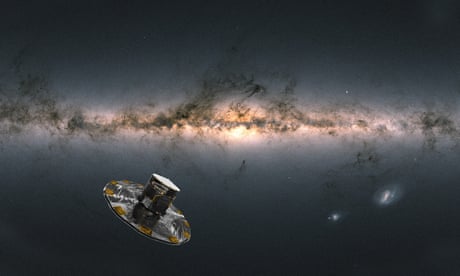Astronomers have unveiled the most detailed survey of the Milky Way, revealing thousands of “starquakes” and stellar DNA, and helping to identify the most habitable corners of our home galaxy. The observations from the European Space Agency’s Gaia probe cover almost two billion stars – about 1% of the total number in the galaxy – and are allowing astronomers to reconstruct our home galaxy’s structure and find out how it has evolved over billions of years. Previous surveys by Gaia , a robotic spacecraft launched in 2013, have pinpointed the motion of the stars in our home galaxy in exquisite detail.
By rewinding these movements astronomers can model how our galaxy has morphed over time. The latest observations add details of chemical compositions, stellar temperatures, colours, masses and ages based on spectroscopy, where starlight is split into different wavelengths. These measurements unexpectedly revealed thousands of starquakes, cataclysmic tsunami-like events on the surface of stars.
“Starquakes teach us a lot about stars – notably, their internal workings,” said Conny Aerts of KU Leuven in Belgium, who is a member of the Gaia collaboration. “Gaia is opening a goldmine for asteroseismology of massive stars. ” Dr George Seabroke, senior research associate at Mullard space science laboratory at University College London, said: “If you can see these stars changing in brightness halfway across the Milky Way, if you were anywhere near them, it would be like the sun changing shape in front of your eyes.
” Gaia is fitted with a 1bn pixel camera – the largest ever in space – complete with more than 100 electronic detectors. The latest dataset represents the largest chemical map of the galaxy to date, cataloguing the composition of six million stars, ten times the number measured in previous ground-based catalogues. What stars are made of can tell us about their birthplace and their journey afterwards, and help unravel the history of the Milky Way.
The first primordial stars, formed shortly after the Big Bang, only had light elements – hydrogen and helium – available. These produced the first supernovae that enriched galaxies with metals and elements such as carbon and oxygen, and with successive generations of stars more heavy elements became available. A star’s chemical composition is a bit like its DNA, giving us crucial information about its origin.
Sign up to First Edition, our free daily newsletter – every weekday morning at 7am BST Gaia revealed that some stars in our galaxy are made of primordial material, while others like our Sun are made of matter enriched by previous generations of stars. Stars that are closer to the centre and plane of our galaxy are richer in metals than stars at larger distances. Gaia also identified stars that originally came from different galaxies than our own, based on their chemical composition.
“Our galaxy is a beautiful melting pot of stars,” said Alejandra Recio-Blanco of the Observatoire de la Côte d’Azur in France, who is a member of the Gaia collaboration. “This diversity is extremely important, because it tells us the story of our galaxy’s formation. ” Seabroke said that tracing the “metallicity gradient” through the galaxy can help pin down habitable regions of the Milky Way.
“If the Sun was born in a region with much higher metallicity, there would be many more supernovae going off, presenting a risk to life on Earth,” he said. The headline of this article was amended on 13 June 2022. The original version referred to “stella” DNA.
The correct spelling is “stellar”. .
From: theguardian
URL: https://www.theguardian.com/science/2022/jun/13/gaia-probe-reveals-stella-dna-and-unexpected-starquakes



